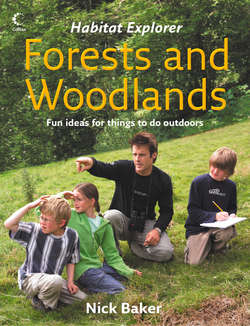Читать книгу Forests and Woodlands - Nick Baker - Страница 7
Is your wood ancient?
ОглавлениеMany woodlands have been a feature of our landscape for a long time while others have been cleared and have either been re-colonized or re-planted. While all woodlands offer shelter and food for certain creatures, those that have been around for longer tend to have a greater number of species. This variety of species is called biodiversity.
In the spring, investigate your local woodland. Is it ablaze with colour, as a carpet of plants explode into flower and leaf? There is only a brief window of warmth and light in a wood before the leafy canopy closes over and returns most of the wood floor into the dappled half light. This is why so many plants in the understorey have broad leaves (see also opposite).
We humans have real trouble thinking outside of our own life expectancy. We tend to think that we have had a good innings if we get to 80 years old, but most trees at 80 have barely got going. Living at a slower speed than us is part of their fascination. As long-lived plants, they have their own stories to tell. They are like living history lessons, telling us about their own lives and the conditions to which they were exposed as they grew.
Get to know some of the truly old trees in your area. Work out their age (see pages 18–19 and the Take it further box, opposite) and learn about their history; perhaps relate it to famous historical events in human history, such as wars and invasions. You will soon get a sense of what events these trees may have stood through. This is the first step to tree appreciation and helps you to enjoy them fully. You can also maybe help a little by planting a few of your own (see pages 24–5).
Look closely at many spring-flowering plants. They have large, broad leaves designed to steal as much of the sparse light that falls on them as possible. Many also grow in large and dense mats, a sign that they reproduce and spread mainly by bulb splitting and underground runners, rather than by seeding. The fact that they spread like this means they tend to be specialized at surviving in woodlands but are next to useless at spreading to new locations. As a result, they take many years to colonize a woodland.
Woods were once used as a crop and their products were used in day-to-day life. Look for multi-trunked trees that seem to grow from a thick and gnarly old base. These may well have been coppiced at some time. This is the process of harvesting the straight poles that sprout from a cut stump. Some of these would be used for building poles or for making hurdles or fences, while others would be burnt to produce charcoal for smithies and home fires. Today, coppicing still goes on in some woods.
Take it further
* Other clues to the age and use of a woodland or hedgerow can be found by looking for tell-tale traces of how man has managed them.
* Old woods tend to have uneven and curved boundaries while new ones are usually straighter.
* Plants are another great way to tell if a woodland is ancient. Look for:
Bluebell
Wood anemone
Pignut
Wild garlic
Wood sorrel
Dog’s mercury
Cow wheat
Primrose
Wild daffodil
Early dog violet
